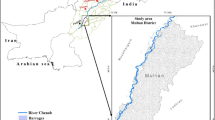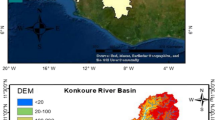Abstract
Every summer, North Korea (NK) suffers from floods, resulting in decreased agricultural production and huge economic loss. Besides meteorological reasons, several factors can accelerate flood damage. Environmental studies about NK are difficult because NK is inaccessible due to the division of Korea. Remote sensing (RS) can be used to delineate flood inundated areas in inaccessible regions such as NK. The objective of this study was to investigate the spatial characteristics of flood susceptible areas (FSAs) using multi-temporal RS data and digital elevation model data. Such study will provide basic information to restore FSAs after reunification. Defining FSAs at the study site revealed that rice paddies with low elevation and low slope were the most susceptible areas to flood in NK. Numerous sediments from upper streams, especially streams through crop field areas on steeply sloped hills, might have been transported and deposited into stream channels, thus disturbing water flow. In conclusion, NK floods may have occurred not only due to meteorological factors but also due to inappropriate land use for flood management. In order to mitigate NK flood damage, reforestation is needed for terraced crop fields. In addition, drainage capacity for middle stream channel near rice paddies should be improved.












Similar content being viewed by others
References
Abramovitz, J. N., & Dunn, S. (1998). Record year for weather-related disasters. (Vol. 5). Washington, DC: Vital Signs Brief, Worldwatch Institute.
Anselin, L. (1995). Local indicators of spatial association—LISA. Geographical Analysis, 27(2), 93–115.
Brivio, P. A., Colombo, R., Maggi, M., & Tomasoni, R. (2002). Integration of remote sensing data and GIS for accurate mapping of flooded areas. International Journal of Remote Sensing, 23(3), 429–441. doi:10.1080/01431160010014729.
Choi, Y. H. (2000). Prevention of farmland flooded. Journal of Environmental Research, 17, 226–250.
Chubey, M. S., & Hathout, S. (2004). Integration of RADARSAT and GIS modelling for estimating future Red River flood risk. GeoJournal, 59(3), 237–246. doi:10.1023/B:GEJO.0000026693.87089.83.
Dhakal, A. S., Amada, T., Aniya, M., & Sharma, R. R. (2002). Detection of areas associated with flood and erosion caused by a heavy rainfall using multitemporal Landsat TM data. Photogrammetric Engineering and Remote Sensing, 68(3), 233–239.
Dormels, R. (2014). Profiles of the cities of DPR Korea - Nampho. In Norht Korea's Cities. Seoul: Jimoondang.
ESRI (2016). How Cluster and Outlier Analysis: Anselin Local Moran's I (Spatial Statistics) works. http://resources.esri.com/help/9.3/arcgisengine/java/gp_toolref/spatial_statistics_tools/how_cluster_and_outlier_analysis_colon_anselin_local_moran_s_i_spatial_statistics_works.htm. Accessed 14 April 2016.
Frazier, P. S., & Page, K. J. (2000). Water body detection and delineation with Landsat TM data. Photogrammetric Engineering and Remote Sensing, 66(12), 1461–1468.
Giacomelli, A., Mancini, M., & Rosso, R. (1995). Assessment of flooded areas from ERS-1 PRI data: an application to the 1994 flood in northern Italy. Physics and Chemistry of the Earth, 20(5–6), 469–474. doi:10.1016/S0079-1946(96)00008-0.
Gunjal, K., Goodbody, S., Luma, J. K., & Bhatia, R. (2010). FAO/WFP crop and food security assessment mission to the Democratic People's Republic of Korea. ROME: Food and Agriculture Organization of the United Nations / World Food Programme.
Gunjal, K., Goodbody, S., Coslet, C., Hollema, S., Vurumuku, E., Singhkumarwong, A., et al. (2012). FAO/WFP crop and food security assessment mission to the Democratic People's Republic of Korea. ROME: Food and Agriculture Organization of the United Nations/World Food Programme.
Gunjal, K., Goodbody, S., Hollema, S., Ghoos, K., Wanmali, S., Krishnamurthy, k., et al. (2013). FAO/WFP crop and food security assessment mission to the Democratic People's Republic of Korea. ROME: Food and Agriculture Organization of the United Nations / World Food Programme.
Hack, J. T. (1957). Studies of longitudinal stream profiles in Virginia and Maryland. US Geological Survey Professional Paper, 294-B, 45–97.
Hong, J. H., & Hwang, J. H. (2006). Analysis on the change of regional vulnerability to flood. Journal of Environmental Policy, 5(4), 1–18.
Hudson, P. F., & Colditz, R. R. (2003). Flood delineation in a large and complex alluvial valley, lower Pánuco basin, Mexico. Journal of Hydrology, 280(1–4), 229–245. doi:10.1016/S0022-1694(03)00227-0.
Jain, S., Singh, R. D., Jain, M. K., & Lohani, A. K. (2005). Delineation of flood-prone areas using remote sensing techniques. Water Resources Management, 19(4), 333–347. doi:10.1007/s11269-005-3281-5.
Jang, M. W., Choi, J. Y., & Lee, J. J. (2007). A spatial reasoning approach to estimating paddy rice water demand in Hwanghaenam-do, North Korea. Agricultural Water Management, 89(3), 185–198.
Jasiewicz, J. (2016). r.stream.order. http://resources.esri.com/help/9.3/arcgisengine/java/gp_toolref/spatial_statistics_tools/how_cluster_and_outlier_analysis_colon_anselin_local_moran_s_i_spatial_statistics_works.htmr.stream.order.html. Accessed 14 April 2016.
Jin, R., Yoo, J. Y., & Lee, K. S. (2015). Investigation of urban flooding characteristics due to heavy summer rainfall in Seoul using GIS. Journal of the Korean Society of Hazard Mitigation, 15(6), 101–108.
Kim, Y. O. (2016a). Jaeryeong Plain. http://encykorea.aks.ac.kr/Contents/Index?contents_id=E0048984. Accessed 14 April 2016.
Kim, Y. O. (2016b). South Pyeongan Province. http://encykorea.aks.ac.kr/Contents/Index?contents_id=E0059919. Accessed 14 April 2016.
Kim, C., Choi, J., & Joung, G. (1998). A pilot study on environmental evaluating and estimation of the North Korea flooded area using spaceborne scanner data. (pp. 252): The Korean Federation of Science and Technology Societies.
Kim, S. J., Suh, K., Kim, S. M., Lee, K. D., & Jang, M. W. (2013). Mapping of indundation vulnerability using geomorphic characteristics of flood-damaged farmlands—a case study of Jinju City. Journal of Korean Society of Rural Planning, 19(3), 51–59.
Korea Meterological Administration (2015). Domestic climate data. http://www.kma.go.kr/weather/climate/average_north.jsp?pg=18&do=06&si=2. Accessed 14 April 2016.
Korea Ministry of Unification (2014). Annual rainfall damages status in North Korea. http://nkinfo.unikorea.go.kr/nkp/overview/nkOverview.do?sumryMenuId = SO322. Accessed January 24 2017.
Korea National Emergency Management Agnecy (2013). 2012 Disaster Yearbook. (Vol. 2013).
Lee, S. H. (2004). Situation of degraded forest land in DPRK and strategies for forestry cooperation between South and North Korea. Journal of Agriculture & Life Sciences, 38(3), 101–113.
Liu, Z., Huang, F., Li, L., & Wan, E. (2002). Dynamic monitoring and damage evaluation of flood in north-west Jilin with remote sensing. International Journal of Remote Sensing, 23(18), 3669–3679. doi:10.1080/01431160010006953.
Manavalan, P., Sathyanath, P., & Rajegowda, G. (1993). Digital image analysis techniques to estimate waterspread for capacity evaluations of reservoirs. Photogrammetric Engineering and Remote Sensing, 59(9), 1389–1395.
Miehener, W. K., & Houhoulis, P. F. (1997). Detection of vegetation changes associated with extensive flooding in a forested ecosystem. Photogrammetric Engineering and Remote Sensing, 63(12), 1363–1374.
Moran, P. A. (1950). Notes on continuous stochastic phenomena. Biometrika, 37(1/2), 17–23.
Myeong, S., Hong, H., Choi, H., & Jeong, J. (2008). Estimation of flood vulnerable areas in North Korea and collaboration strategies between South Korea and North Korea. (Vol. 2008, pp. 1–203). Korea: Korea Environment Institute.
Myeong, S., Kim, J., Lim, M., Hwang, S., Son, G., Ahn, J., et al. (2013). A study on constructing a cooperative system for South and North Koreas to counteract climate change on the Korean Peninsula III. (Vol. 2013, pp. 2621-3142). Korea: Korea Environment Institute.
Okamoto, K., Yamakawa, S., & Kawashima, H. (1998). Estimation of flood damage to rice production in North Korea in 1995. International Journal of Remote Sensing, 19(2), 365–371. doi:10.1080/014311698216332.
Overton, I. (1997). Satellite image analysis of river Murray floodplain inundation. NRMS Project, 6045.
Pradhan, B. (2010). Flood susceptible mapping and risk area delineation using logistic regression, GIS and remote sensing. Journal of Spatial Hydrology, 9(2).
Sanyal, J., & Lu, X. X. (2004). Application of remote sensing in flood management with special reference to monsoon Asia: a review. Natural Hazards, 33(2), 283–301. doi:10.1023/B:NHAZ.0000037035.65105.95.
Sanyal, J., & Lu, X. X. (2005). Remote sensing and GIS-based flood vulnerability assessment of human settlements: a case study of Gangetic West Bengal, India. Hydrological Processes, 19(18), 3699–3716.
Shaikh, M., Brady, A., & Sharma, P. Applications of remote sensing to assess wetland inundation and vegetation response in relation to hydrology in the Great Cumbung Swamp, Lachlan Valley, NSW, Australia. In Wetlands for the Future. Proceedings of the Fifth International Wetland Conference, Perth, WA, 1998 (pp. 595–606)
Shibayama, M., & Akiyama, T. (1989). Seasonal visible, near-infrared and mid-infrared spectra of rice canopies in relation to LAI and above-ground dry phytomass. Remote Sensing of Environment, 27(2), 119–127. doi:10.1016/0034-4257(89)90011-4.
Townsend, P. A., & Walsh, S. J. (1998). Modeling floodplain inundation using an integrated GIS with radar and optical remote sensing. Geomorphology, 21(3–4), 295–312.
Wang, Y., Colby, J., & Mulcahy, K. (2002). An efficient method for mapping flood extent in a coastal floodplain using Landsat TM and DEM data. International Journal of Remote Sensing, 23(18), 3681–3696.
Yamagata, Y., Wiegand, C., Akiyama, T., & Shibayama, M. (1988). Water turbidity and perpendicular vegetation indices for paddy rice flood damage analyses. Remote Sensing of Environment, 26(3), 241–251. doi:10.1016/0034-4257(88)90080-6.
Acknowledgements
This research was supported by a grant (S-2012-0796-000-1) funded by the Samsung Academic Research.
Author information
Authors and Affiliations
Corresponding author
Rights and permissions
About this article
Cite this article
Lim, J., Lee, Ks. Investigating flood susceptible areas in inaccessible regions using remote sensing and geographic information systems. Environ Monit Assess 189, 96 (2017). https://doi.org/10.1007/s10661-017-5811-z
Received:
Accepted:
Published:
DOI: https://doi.org/10.1007/s10661-017-5811-z




